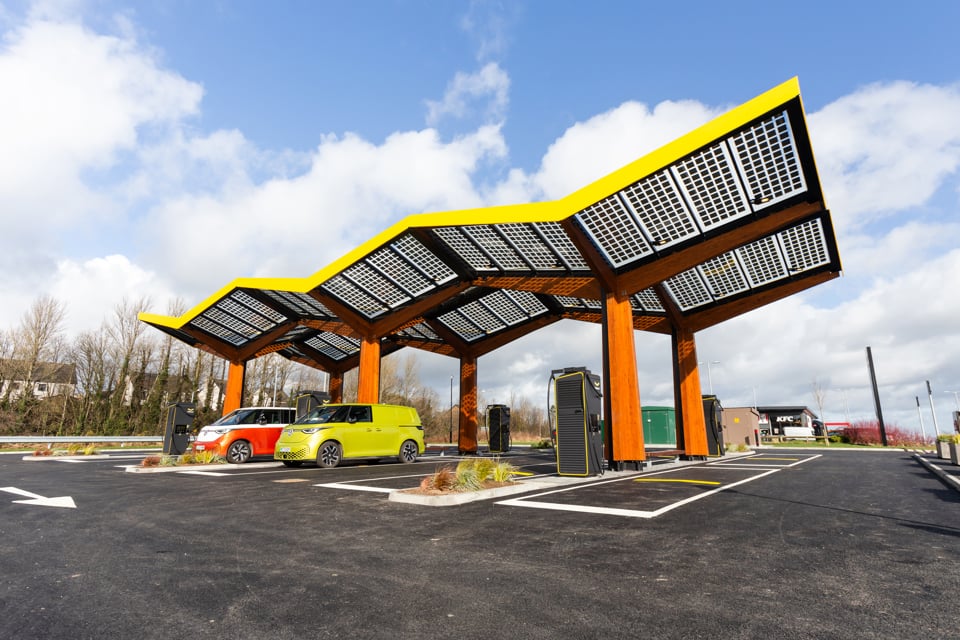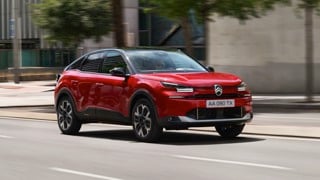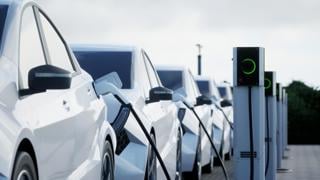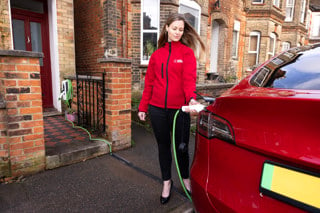The number of public electric vehicle charging devices grew by 28% in the past year, with almost 17,000 charge points added to the UK network since April 2024.
The new figures, from the Department for Transport (DfT), suggest strong growth in the North (up 30%), West Midlands (up 44%) and East of England (up 43%).
However, public charging availability varies significantly across the country, with the number of devices falling in in the North East and Northern Ireland since the start of the year.
Scotland had the greatest percentage increase at 9.2%, while London had the greatest increase in absolute number of devices at 1,084 devices.
There was a decrease of 1.2% in the North East and Northern Ireland, while there was almost no growth in the East Midlands.
The decrease in devices in the North East since the previous quarter is due to a charge point operator changing the mechanism for how they report their data to Zapmap, according to the DfT.
A number of devices were added to the data between October and December, inflating the total increase in the region to 12.5% in the previous quarter.
This was subsequently followed by a similar number of devices being removed from the same charge point operator’s data feed, reverting the number of devices back down and causing the 1.2% decrease seen in this release
Change in public charging devices per region between from January to April
There were 76,507 public electric vehicle charging devices installed in the UK as of April 1.
One-in-five (15,446) charge points delivered 50kW of power or above, while 42,874 were in the lowest power rating banding, 3kW up to 8kW, which represents 56% of all charging devices.
Public charging devices by charging speed
Some 37,435 were designated as ‘destination’ chargers – almost half (49%) of all devices, with 28,316 designated as ‘on street’ chargers, representing more than a third (37%) of all charge points.
Future of roads minister Lilian Greenwood said: “We want to make sure that drivers are always close to an electric vehicle charging device – no matter where they are – and that’s why it’s great to see the number of public charging devices across the UK growing by 28% since April last year.
“There are now more than 76,500 public electric vehicle charging devices available, with strong growth in previously underserved regions like the North, the Midlands and the East of England.”
There is an uneven geographical distribution in total charging devices across the UK.
This distribution is more evenly spread for charging devices rated 50kW and above, but some regional disparities remain, says the DfT.
Some local authorities have bid for Government funding for charging devices, and others have not.
Most of the provision of this infrastructure has been market-led, with individual charging networks and other businesses (such as hotels) choosing where to install devices.
Public charging devices per 100,000 of population by UK country and region
London had a much higher level of charging provision per 100,000 of population than any other part of the UK, with 263 devices per 100,000. In comparison, the average provision in the UK was 113 per 100,000.
Northern Ireland had the lowest level of charging device provision in the UK, with 35 devices per 100,000, followed by Yorkshire and the Humber with 66 devices per 100,000.
In terms of charge points delivering 50kW or higher, Scotland had the highest rate of provision at 34 charging devices rated 50kW and above per 100,000.
The average provision in the UK was 22.9 per 100,000.
It was lowest in Northern Ireland with 9.9 charging devices rated 50kW and above per 100,000.
Most other regions have far more comparable 50kW or above device provision per 100,000 population.
Despite having a much higher number of total charging devices per 100,000 population than the rest of the UK, London was the region with the second lowest number of 50kW and above rated devices with 15.4 charging devices rated 50kW and above per 100,000.
This is because most of London’s charging provision is devices rated 3kW up to 8kW located on residential streets.
Public 50kW and above charging devices per 100,000 of population
Phil Douglass, Vauxhall Electric Streets director, said: “Access to convenient charging is crucial in supporting drivers make the move to electric vehicles and it’s encouraging to see the number of on-street chargers continue to grow, with a strong 28% increase in devices compared to April 2024.
“However, just as important as the number of chargers growing is devices being installed in the right place.
“Through Electric Streets of Britain, over 1,000 residents in the North East and Northern Ireland have registered the need for on-street charging near them.
“It is important that local authorities continue to consider the needs of drivers nationwide to make sure no part of the country is left behind on the electrification journey.”
Separate analysis by Octopus Electroverse, for its new Charging Infrastructure Insights report, suggest that there are more than 100,000 public charge points available to drivers in the UK.
Matt Davies, director of Octopus Electroverse, said: “We’re well on track to turning the Government’s 300,000 target by 2030 into a reality.”
Asif Ghafoor, CEO of national charging network BeEV, believes there is enough infrastructure out there for EV drivers and it is on track to keep pace with demand.
However, he said: “What we need now is to upgrade the old chargers that are giving the industry a bad rep.
“It’s not a case of installing chargers and then you’re done. Charging providers have a responsibility to make sure chargers are upgraded and suit what drivers want today, not what they wanted three years ago.
“For example, contactless should be a given at all chargers, which it isn’t currently. This will greatly improve the driver experience and give non-EV drivers yet another reason to make the switch.
“We also need more signposting on roads and motorways, which will help to bring an end to the outdated reliance on chargers at motorway service stations.
“Many drivers use their car or apps for this, but signposting will help drive behaviour change and encourage drivers to find better EV charging hubs outside of where they used to refuel.
“Many are located less than ten minutes away from motorways, where the chargers are less busy (and the food and drink is cheaper).
“What we need to challenge is the perception of poor range. It’s clear that there are more than enough chargers, we just need to do a better job of letting drivers know that this is the case. Signs that actually tell them where they are would go a long way.”



























Login to comment
Comments
No comments have been made yet.